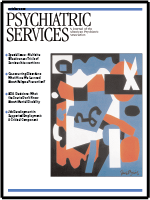Service Use and Costs for Women With Co-occurring Mental and Substance Use Disorders and a History of Violence
Abstract
OBJECTIVES: This study examined the 12-month cost of the array of services used by women with co-occurring mental health and substance use disorders and a history of violence and trauma who participated in the Women, Co-occurring Disorders, and Violence Study (WCDVS). The study compared costs of the intervention and external services for women in the WCDVS intervention in outpatient and residential settings—which provided comprehensive, integrated, and trauma-informed services—with the costs for women in the usual-care comparison group. The study also compared costs with recorded clinical outcomes. METHODS: Costs of service use were examined for 2,026 women who participated in the WCDVS (N=1,018) and in the comparison group (N=1,008). Women were interviewed three, six, nine, and 12 months after baseline about any service use in the past three months. Costs for these services, along with indirect costs (participants' time and transportation) were estimated by using a variety of sources. A number of cost estimates were analyzed by using either ordinary least squares regression or two-part models. RESULTS: The average participant had almost $43,000 in costs related to their service use during the 12 months after baseline. Women in the intervention group had lower service costs and higher overall costs than those in the comparison group, but the null hypotheses of no difference in any cost measure between groups was not rejected. Also, the null hypothesis of no difference in the probability of accessing services external to the study intervention was not rejected. CONCLUSIONS: Because no differences were detected in costs but improvements were seen in clinical outcomes, the interventions offered in the WCDVS may be more efficient than usual care.



